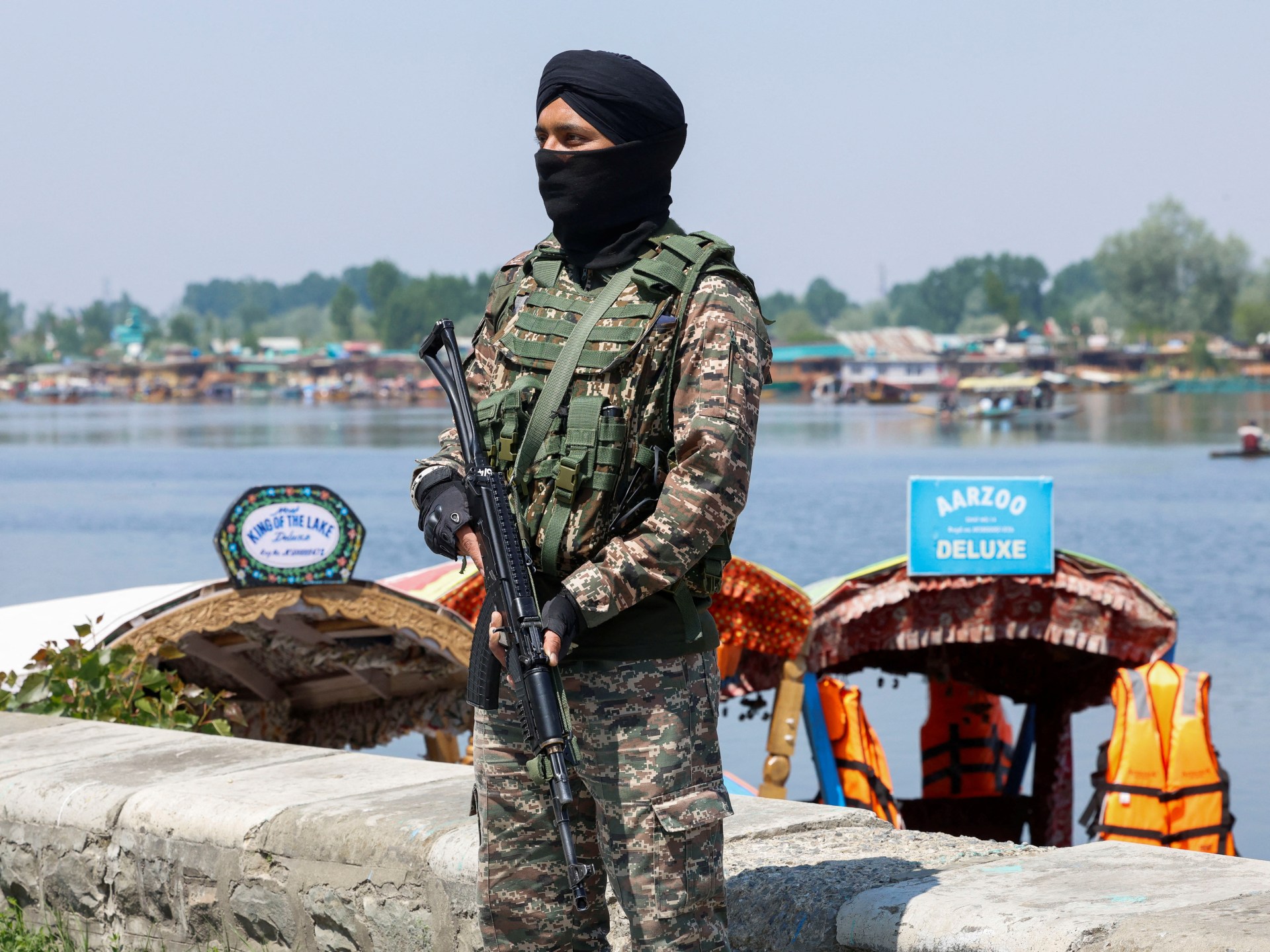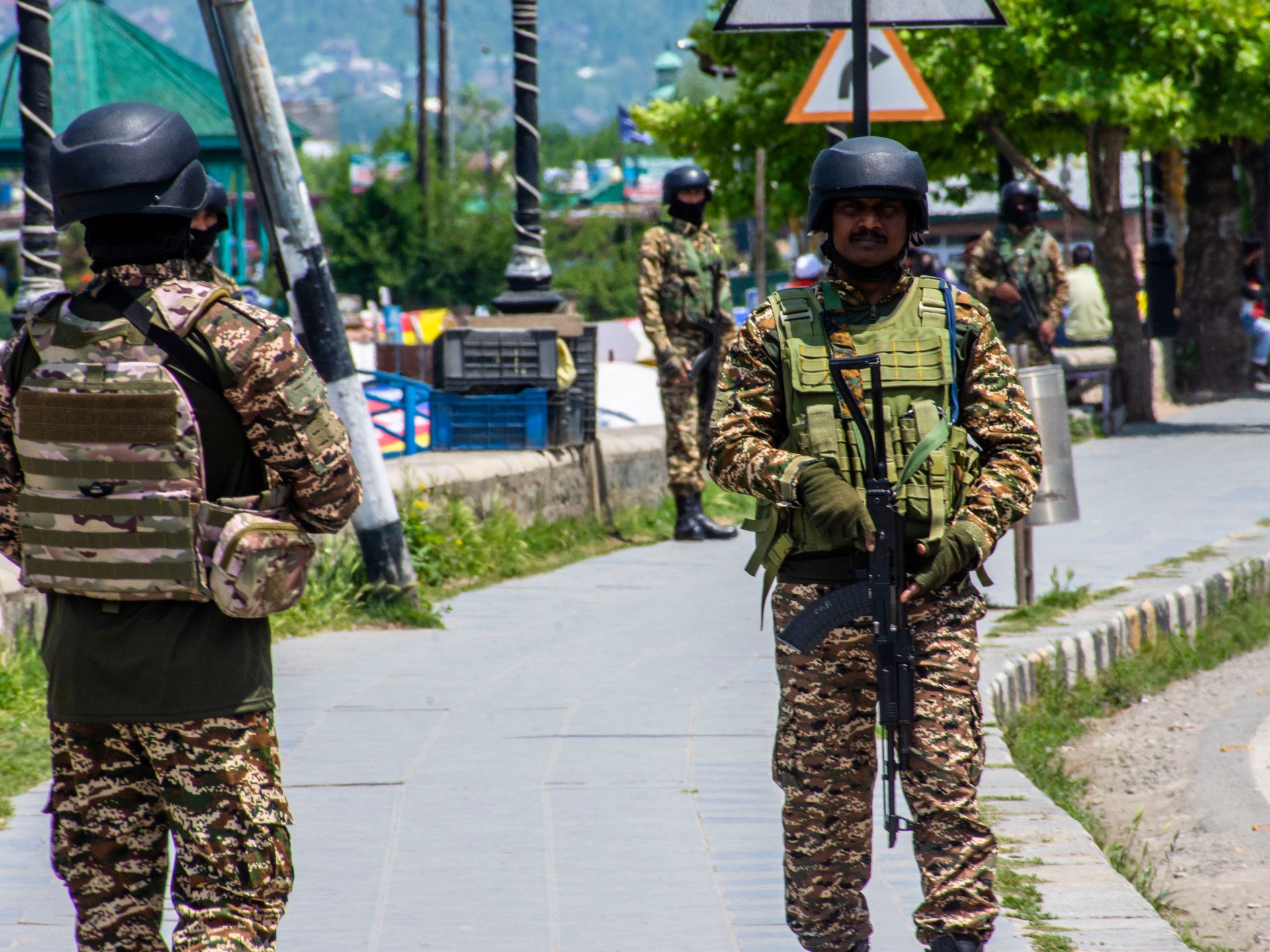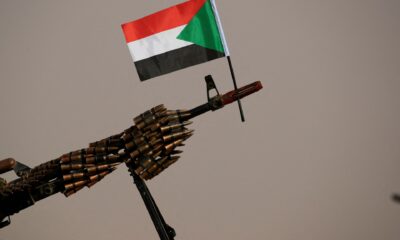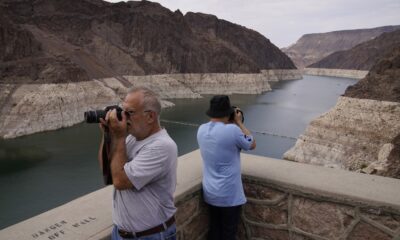Conflict Zones
‘Burst balloon’: How Pahalgam attack shattered Modi’s Kashmir narrative | Narendra Modi News

New Delhi, India — Addressing a rally of supporters in September 2024, Indian Prime Minister Narendra Modi confidently asserted that his Hindu majoritarian Bharatiya Janata Party (BJP) would create a new Jammu and Kashmir, “which would not only be terror-free but a heaven for tourists”.
Seven months later, that promise lies in tatters. On April 22, an armed group killed 25 tourists and a local pony rider in the resort town of Pahalgam in Indian-administered Kashmir, setting off an escalatory spiral in tensions between India and Pakistan, which New Delhi accuses of links to the attackers – a charge Islamabad has denied.
The armies of the two nuclear-armed neighbours have exchanged gunfire for three days in a row along their disputed border. India has suspended its participation in the Indus Waters Treaty (IWT) that Pakistan counts on for its water security, and Islamabad has threatened to walk out of past peace deals. Both nations have also expelled each other’s diplomats, military attaches and hundreds of civilians.
But India is simultaneously waging a battle on territory it controls. In Indian-administered Kashmir, security forces are blasting the homes of families of suspected armed fighters. They have raided the homes of hundreds of suspected rebel supporters and arrested more than 1,500 Kashmiris since the Pahalgam killings, the deadliest attack on tourists in a quarter of a century.
Yet, as Indian forces comb dense jungles and mountains to try to capture the attackers who are still free, international relations experts and Kashmir observers say the past week has revealed major chinks in Modi’s Kashmir policy, which they say appears to be staring at a dead end.
The Pahalgam attack “punctured the balloon of the ‘New Kashmir’ narrative”, said Sumantra Bose, a political scientist whose work focuses on the intersection of nationalism and conflict in South Asia.

‘Making tourists a target’
In August 2019, the Modi government withdrew the semi-autonomous status of Indian-administered Kashmir without consultation with either the political opposition or Kashmiris. That special status had been a critical condition for Kashmir to join India following independence from the British in 1947.
The Modi government argued that successive governments had failed to truly integrate Jammu and Kashmir with the rest of India, and that the semi-autonomous status had played into the hands of secessionist forces that seek to break the region from India.
The abrogation of the constitutional provision that gave Kashmir its special status was accompanied by a major crackdown. Thousands of civilians were arrested, including leaders of mainstream political parties – even those that view Kashmir as a part of India. Phone and internet connections were shut off for months. Kashmir was cut off from the rest of the world.
Yet, the Modi government argued that the pain was temporary and needed to restore Kashmir to what multiple officials described as a state of “normalcy”.
Since then, the arrests of civilians, including journalists, have continued. Borders of electoral constituencies were changed in a manner that saw Jammu, the Hindu-majority part of Jammu and Kashmir, gain greater political influence than the Muslim-majority Kashmir valley. Non-Kashmiris have been issued residency cards – which was not allowed before 2019 – to settle there, sparking fears that the Modi government might be attempting to change the region’s demography.
And though the region held the first election to its provincial legislature in a decade in late 2024, the newly elected government of Chief Minister Omar Abdullah has been denied many of the powers other regional governments enjoy – with New Delhi, instead, making key decisions.
Amid all of that, the Modi government pushed tourism in Kashmir, pointing to a surge in visitors as evidence of the supposed normalcy that had returned to the return after four decades of armed resistance to Indian rule. In 2024, 3.5 million tourists visited Kashmir, comfortably the largest number in a decade, according to government figures.
But long before the Pahalgam attack, in May 2024, Abdullah – now, the chief minister of the region, then an opposition leader – had cautioned against suggesting that tourism numbers were reflective of peace and stability in Kashmir.
“The situation [in Kashmir] is not normal and talk less about tourism being an indicator of normalcy; when they link normalcy with tourism, they put tourists in danger,” Abdullah said in May last year. “You are making the tourists a target.”

Al Jazeera reached out to Abdullah for a comment on the current crisis but has yet to receive a response.
On April 22, that Modi government narrative that Abdullah had warned about was precisely what left the meadows of Pahalgam splattered in blood, said Praveen Donthi, a senior analyst at the International Crisis Group. “New Delhi and its security agencies started buying their own assessment of peace and stability, and they became complacent, assuming that the militants will never attack tourists,” he said.
Until the Pahalgam attack, armed fighters had largely spared tourists in Kashmir, keeping in mind their importance to the region’s economy, noted Donthi. “But if pushed to the wall, all it takes is two men with guns to prove that Kashmir is not normal,” he said.
Dealing with Kashmir, dealing with Pakistan
On April 8, just two weeks before the attack, Indian Minister of Home Affairs Amit Shah, who is widely seen as Modi’s deputy, was in Srinagar, Kashmir’s largest city, to chair a security review meeting. Abdullah, the chief minister, was not a part of the meeting – the most recent instance where he has been kept out of security reviews.
Analysts say this underscores that the Modi government views Kashmir’s security challenges almost exclusively as an extension of its foreign policy tensions with Pakistan, not as an issue that might also need domestic input for New Delhi to tackle it successfully. India has long accused Pakistan of arming, training and financing the armed rebellion against its government in Indian-administered Kashmir. Pakistan claims it only offers moral and diplomatic support to the secessionist movement.
The Pahalgam attack has shone a light on the folly of the Modi administration’s approach, Donthi said.
“Projecting this as a security crisis that is being fuelled entirely by Pakistan can make it useful politically, domestically, but it’s not going to help you resolve the conflict,” he said.
“Unless the Indian government starts engaging with the Kashmiris, there can never be a durable solution to this violence.”
So far, though, there is little evidence that the Modi government is contemplating a shift in approach, which appears shaped “to cater to domestic jingoism and hyper-nationalist rhetoric”, Sheikh Showkat, a Kashmir-based political commentator, said.
The focus since the Pahalgam attack has been to punish Pakistan.
Since 1960, the IWT – the water-sharing agreement between India and Pakistan – survived three wars and has been widely hailed as an example of managing transnational waters.
Under the treaty, both countries get water from three rivers each, from the Indus Basin: three eastern rivers – the Ravi, Beas and Sutlej – to India, while three western rivers – the Indus, Jhelum and Chenab – carry 80 percent of water to Pakistan.
But the future of that pact is uncertain with India suspending its participation in the treaty after the Pahalgam attack. Pakistan has responded by warning that attempts to stop or divert water resources would amount to “an act of war”. Islamabad has also warned that it might suspend its participation in all bilateral treaties, including the 1972 Simla Agreement, signed after their 1971 war, which in essence demarcates the Line of Control, the de-facto border, between them.

“Pakistan genuinely views this matter [the loss of water] in existential and even apocalyptic terms,” said Bose, the political scientist. “India knows this – and it signals a policy of collective punishment towards Pakistan, which impacts tens of millions of people.”
However, experts have raised several questions about India’s and Pakistan’s announcements.
How can India practically stop water when it does not have the capacity to hold these powerful rivers? Can it divert water, risking flooding in its own territory? And if Pakistan walks away from the Simla Agreement, is it in effect signalling a state of war?
“All of these measures are juvenile, on both sides,” said Bose, but with “concrete implications”.
For its part, India has been seeking to renegotiate the IWT for several years, claiming that it does not get its fair share of the water. “The recent Kashmir crisis gives [New] Delhi an opportunity, a pretext to pull the trigger on the treaty,” said Showkat, the Kashmiri-based commentator.

Will Modi change his Kashmir approach?
Two days after the Pahalgam attack, Modi was touring Bihar, the eastern state due for elections later this year. Addressing an election rally, the prime minister said that he would chase the attackers “to the end of the earth”.
To Nilanjan Mukhopadhyay, a Modi biographer, such speeches are reflective of what he argues is the sole objective of Modi’s Kashmir policy: “maximising the core electoral constituency of the BJP in the rest of the country by being tough on Kashmir”.
Since independence, the BJP’s ideological parent, the Rashtriya Swayamsevak Sangh, has viewed Kashmir as an unfinished project: The RSS for decades called for the region’s special status to be scrapped, and for a firm security-driven approach to the Muslim-majority region.
“Now, the only thing is, ‘We want revenge’,” said Mukhopadhyay, referring to the jingoism that currently dominates in India.
Since the attack, several Kashmiris have been beaten up across India, with landlords pushing out tenants and doctors turning away Muslim patients. Social media platforms are rife with inflammatory content targeting Muslims.
The International Crisis Group’s Donthi said that the Pahalgam attack, in some ways, serves as “a shot in the arm” for Modi’s government. While the security challenges in Kashmir and the crisis with Pakistan represent strategic and geopolitical tests, “domestically, it is a great position for the Modi government to be in”.
He said this was especially so with a weak opposition largely falling in line – the principal opposition Congress party has backed a muscular response to Pakistan for the attack.
However, Bose, the political scientist, argues that the Modi government was not focused on short-term political calculations. Modi’s comments in Bihar, and the largely unchecked hate against Kashmiris and Muslims spreading across Indian social platforms and on TV channels, were reflective of the BJP’s broader worldview on Kashmir, he said.
Kashmir is an ideological battle for Modi’s party, he said, adding, “This government is never going to change its Kashmir policy.”
Conflict Zones
Kashmir attack: Why Pakistan’s threat to suspend Simla Agreement matters | Conflict News

Islamabad, Pakistan – Tensions between India and Pakistan have soared since the April 22 attack on tourists in the scenic resort town of Pahalgam in Indian-administered Kashmir, in which at least 26 people were killed.
Both countries have announced a series of tit-for-tat measures, raising fears of a wider confrontation.
After a cabinet meeting led by Prime Minister Narendra Modi, India on Wednesday announced the suspension of the six-decade-old Indus Waters Treaty (IWT), a critical agreement that governs the use of the Indus River system, vital to both nations. It also announced the closure of its border with Pakistan, trade suspension, revocation of visas, and a reduction in Pakistani diplomats in India.
In response, Pakistan’s National Security Committee (NSC), its top civil-military decision-making body, announced similar measures, including border and airspace closures, suspension of trade, and, significantly, a threat to suspend its participation in all bilateral agreements with India, including the Simla Agreement.
Signed in 1972, the Simla Agreement forms the bedrock of India-Pakistan relations, governing the Line of Control (LoC) and outlining commitments to resolve disputes peacefully.
Pakistan’s threat to suspend the agreement marks a potentially serious escalation. But what exactly is the Simla Agreement, and what are the implications if Pakistan pulls out of it?
What is the Simla Agreement?
Seven months after the 1971 war, which India won and which led to the creation of Bangladesh, Pakistani President Zulfikar Ali Bhutto and Indian Prime Minister Indira Gandhi met in Shimla (sometimes also spelt as Simla), the hilly capital of the Indian state of Himachal Pradesh, to normalise relations.
Key points of the agreement [PDF], signed on July 2, 1972, included the peaceful settlement of disputes and resolving issues, including Kashmir, bilaterally.
It also urged respect for territorial sovereignty, integrity, political independence and noninterference in internal affairs.
One of the most important outcomes was the renaming of the Ceasefire Line, the working border between the two countries, to the Line of Control (LoC), with both sides agreeing not to change it unilaterally.
Following the 1971 war, the agreement also led to the release of more than 90,000 Pakistani prisoners of war India was holding.
“Pending the final settlement of any of the problems between the two countries, neither side shall unilaterally alter the situation, and both shall prevent the organisation, assistance or encouragement of any acts detrimental to the maintenance of peaceful and harmonious relations,” the agreement stated.

Why is Pakistan’s threat significant?
Ahmer Bilal Soofi, a leading international law expert and former legal adviser to the Pakistan government, described the Simla Agreement as an interim but crucial framework between the two countries.
“Suspending the agreement would require a meticulous internal assessment” by Pakistan to ensure that it serves the country’s interests in retaliating against India, Soofi told Al Jazeera. “Any decision must involve extreme due diligence.”
Another international law expert, Muhammad Mushtaq Ahmad of Shifa Tameer-e-Millat University, explained that India has long interpreted the Simla Agreement as superseding United Nations Security Council (UNSC) resolutions.
“India’s position is that the agreement made the Kashmir issue a purely bilateral matter, removing any need for international mediation,” Ahmad said.
The Himalayan territory has been a flashpoint between the two countries since they gained independence from British rule in 1947, with each controlling parts of Kashmir but claiming it in full. Since independence, the nuclear-armed neighbours have fought four wars, three of them over Kashmir.
Pakistan, on the other hand, maintains that the Simla Agreement reaffirmed UNSC resolutions advocating a diplomatic and political solution.
After the Modi government revoked Indian-administered Kashmir’s semi-autonomous status in 2019, Pakistan accused New Delhi of violating the Simla Agreement.
Islamabad could cite that to justify the suspension of its participation in the agreement, Ahmad said. Under the Vienna Convention on the Law of Treaties – a pact Pakistan is signatory to, but India is not – a material breach allows a country to denounce a treaty, he added.
But Indian defence analyst Ajai Shukla says if either or both countries walk out of the Simla Agreement, it would effectively represent an “open season” on the LoC.
“It could lead to both sides changing the ground position of the LoC, and they will be incentivised to use arms as there won’t be any treaty that will impose peace, which is currently in place,” the New Delhi-based analyst told Al Jazeera.
Does suspending the Simla Agreement mean war?
Despite the Simla Agreement, India and Pakistan have engaged in conflicts, including their four-decade-long joust for control of the Siachen Glacier — the world’s highest battleground — and the 1999 Kargil War.

Ahmad, the academic, said the LoC was never able to establish lasting peace.
Pakistani constitutional expert Rida Hosain argued that India had historically “misused” the Simla Agreement to its advantage.
“At the heart of Simla [Agreement] is peaceful coexistence. But India’s recent war-mongering rhetoric and blame for attacks without evidence suggest otherwise,” Hosain said, referring to India’s allegation that Pakistan was responsible for the Pahalgam attack. Pakistan has rejected the accusation and demanded that India present evidence to support its claim. Islamabad has also called for a “neutral investigation” in to the Kashmir attack.
Shukla, a former Indian Army officer, however, said a pullout by Pakistan from the Simla Agreement would not automatically amount to a declaration of war. Still, it would bring the neighbours closer to a potential military conflict.
“One does not automatically lead to another, but it does mean that both sides will no longer have guardrails of an international treaty that withholds them from engaging in armed hostilities,” he said.
What is Pakistan’s rationale?
Unlike its immediate implementation of other retaliatory measures, Pakistan has only threatened to walk out of the Simla Agreement.
According to Soofi, Pakistan’s rationale stems from a desire to return to multilateralism.
“India has used Simla to argue that Kashmir is a purely bilateral issue. Suspending it allows Pakistan to revert to UN Security Council mechanisms to internationalise the Kashmir dispute,” Soofi said.
Shukla said suspending the agreement could provide international cover for both sides to pursue their interests on the LoC in a manner not possible while adhering to the pact.
“Pakistan always sort of held to the notion that treaties like the Simla Agreement have tied its hands from pursuing its interests in places like Siachen, which Pakistan says is an example of India violating the agreement,” he said. India successfully captured the strategically located Siachen Glacier in 1984 in a military operation that Pakistan insists violated the Simla Agreement.
Meanwhile, India also feels hobbled by the agreement, Shukla said. New Delhi has long insisted that Pakistan-administered Kashmir belongs to India, and under Modi, the domestic rhetoric to militarily take back that territory has grown.
“In essence, both sides feel the agreement is not safeguarding their interests,” said Shukla.
Ahmad suggests that India’s suspension of the IWT could already constitute an act of aggression under international law, justifying self-defence measures by Pakistan. Under the IWT, India gets the waters of the Ravi, Beas and Sutlej rivers, all part of the Indus Basin. On the other hand, Pakistan is entitled to most of the water from the Indus, Jhelum and Chenab rivers.
“The water treaty underpins the lives of nearly 250 million Pakistanis. Its suspension can be seen as a hostile act,” Ahmad said.
The threat to pull out of the Simla Agreement, Ahmad said, was a “smart decision by the government to remind India, to issue them a warning of sorts”.
Conflict Zones
India and Pakistan continue to trade fire across Kashmir border | Conflict News

Fears of wider military escalation persist following a deadly attack on resort town of Pahalgam in Indian-administered Kashmir.
India and Pakistan have exchanged gunfire for a fourth night in a row in the wake of a deadly attack on tourists in Indian-administered Kashmir last week.
The Indian army said it responded to “unprovoked small arms fire” from multiple Pakistan Army posts around midnight on Sunday along the 740km (460-mile) de-facto border separating the Indian and Pakistani areas of the disputed region, which both nations have claimed since their separation in 1947. The persistent cross-border skirmishes have raised fears of wider military escalation between the rival nuclear powers.
The Pakistani military has not yet commented on the latest exchange of fire. No casualties have been reported.
The skirmishes come after gunmen killed 26 people near the resort town of Pahalgam in Muslim-majority Kashmir last Tuesday. It was the deadliest attack on civilians in Indian-administered Kashmir for a quarter of a century.
Security officials and survivors said that gunmen segregated men during the attack, asking their names and targeting Hindus before shooting them at close range.
The attack triggered outrage and grief in India, with New Delhi accusing Pakistan of funding and encouraging “cross-border terrorism” in Kashmir. Islamabad has denied any role and called for a neutral probe.
Following the attack, India launched an extensive security operation, and identified two of the three suspects as Pakistani.
Security forces detained approximately 500 people for questioning and searched nearly 1,000 houses and forests, hunting for the attackers, according to a local police official cited by news agency Reuters.
The two nations have since unleashed a raft of measures against one another.
India has put the critical Indus Waters Treaty in abeyance and sealed its land border with Pakistan. Islamabad has closed its airspace to Indian airlines.
India’s defence forces have conducted several military exercises across the country since the attack. Some of these are routine preparedness drills, a defence official said.
Kashmir Resistance, also known as The Resistance Front, said in a social media post on Sunday that it “unequivocally” denies involvement in the attack.
The group stated that an earlier message that claimed responsibility was the result of a cyberattack, suggesting that it was the work of Indian intelligence.
Conflict Zones
Manila denies China ‘dealt with’ Philippine mission to disputed reef | South China Sea News

Philippine officials say a mission visited Sandy Cay reef in the disputed South China Sea and unfurled the national flag.
The Philippines has denied a Chinese Coast Guard report that China had “dealt with” a situation involving six Filipino personnel, whom Beijing accused of illegally landing on a tiny reef in the disputed South China Sea.
Chinese Coast Guard spokesperson Liu Dejun said in a statement on Sunday evening that six personnel from the Philippines had earlier that day “illegally boarded” the Tiexian Reef, also known as Sandy Cay, despite “warnings and dissuasion” from the Chinese side.
Liu said that Chinese Coast Guard personnel then “boarded the reef and investigated and dealt with it in accordance with the law”. The statement did not provide further details on the encounter or the identities of the six people from the Philippines.
“We urge the Philippines to immediately stop its infringement,” Liu said, adding that the actions “violated China’s territorial sovereignty”.
Officials in Manila denied on Monday that China had taken over Sandy Cay or that a Philippine mission on Sunday to Sandy Cay – a reef over which sand has accumulated – was interfered with by Chinese maritime forces in the disputed area.
Sandy Cay, part of the Spratly Islands, lies near Thitu Island, also called Pag-asa and the site of a Philippine military facility.
“Philippine government officials have categorically denied that China has seized Sandy Cay or has now permanently taken over Sandy Cay in the South China Sea, describing the statement that was released through Chinese state media over the weekend as an ‘outright lie’, as part of Beijing’s disinformation tactics,” Al Jazeera’s Barnaby Lo said, reporting from Manila in the Philippines.
“To prove this point they showed media a recent, as recent as Sunday morning actually, a mission to Sandy Cay by the Philippine Coastguard and the Philippine Navy. Showing photos and videos of the Philippine flag being unfurled on two of the three sand bars that make up Sandy Cay in the South China Sea,” Lo said.
Lo said Philippine officials confirmed that Chinese vessels were present near the disputed reef during the mission on Sunday, but denied that the Philippine mission was “dealt with” as claimed by China.
Chinese state media said on Saturday that the country’s coastguard had “implemented maritime control” over the Tiexian Reef during the middle of April. China’s state broadcaster CCTV said in the report that the Chinese coastguard landed on Sandy Cay to “exercise sovereignty and jurisdiction” over the reef, carry out an “inspection” and “collect video evidence regarding the illegal activities of the Philippine side”.
The broadcaster published a photograph of five people, clad in black, standing on the uninhabited reef as a dark inflatable boat bobbed in the nearby water. Another shot showed four coastguard officials posing with a national flag on the reef’s white surface, in what CCTV described as a “vow of sovereignty”.
According to reports, there is no sign that China has permanently occupied the reef.
Also on Monday, the Philippine and US militaries launched three weeks of annual joint exercises, called “Balikatan” or “shoulder to shoulder”, which will include an integrated air and missile defence simulation for the first time.
Beijing has said the manoeuvres “undermine regional strategic stability” and accused Manila of “collusion with countries outside the region”.
Al Jazeera’s Katrina Yu, reporting from Beijing, said the unfurling of a Chinese flag by the coastguard on Sandy Cay was significant in terms of stating claim to the reef, and the timing in advance of the annual US-Philippine military exercises.
“So it seems that with the staking of this Chinese flag on this reef, it is sending a message not only to Manila but also to Washington,” Yu said.
-

 Africa1 day ago
Africa1 day agoUganda declares end to Ebola outbreak
-

 Middle East23 hours ago
Middle East23 hours agoSaudi Arabia, Qatar to settle Syria’s outstanding debt to World Bank | Business and Economy News
-

 Middle East21 hours ago
Middle East21 hours agoSudan Doctors Network accuses RSF of ‘war crimes’ after 31 killed | Sudan war News
-

 Middle East2 days ago
Middle East2 days agoPalestinian President Mahmoud Abbas appoints aide as PLO deputy | Palestinian Authority News
-

 Lifestyle2 days ago
Lifestyle2 days agoWhite House journalists use annual press dinner to celebrate First Amendment
-

 Lifestyle2 days ago
Lifestyle2 days agoCampgrounds and visitor centers at federal lakes are closing amid Trump’s budget cuts
-

 Europe2 days ago
Europe2 days agoWhat to know about Trump’s proposal to carve up Ukraine
-

 Europe1 day ago
Europe1 day agoFrancis celebrated as ‘pope among the people’ in Vatican funeral attended by massive crowd




